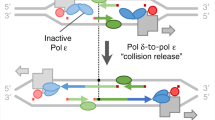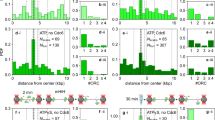Abstract
DNA fragments that show retarded electrophoretic mobility through poly aery lamide gels have been found in both prokaryotes and eukaryotes1–7. In the case of kinetoplast DNA, evidence has been presented that the DNA is curved or ‘bent’8,9. Bent DNA has previously been found at the λ and simian virus 40 (SV40) DNA replication origins6,7. Here we show the existence of bent DNA at a yeast autonomously replicating sequence (ARS1), a putative replication origin. The bent DNA has been localized to a 40–55 base pair (bp) segment and contains six (A)3–5 stretches (that is, six poly(A) stretches, three to five nucleotides in length) phased approximately every 10.5 bp. This region contains a DNA binding site for a yeast protein factor. This site lies at the 3′ end of the TRP1 gene, in a region devoid of nucleosomes, and is positioned 80 bp away from the ARS consensus sequence; removal of this region impairs ARS function in vivo. The bent DNA may be involved in transcription termination or the prevention of nucleosome assembly in this region.
This is a preview of subscription content, access via your institution
Access options
Subscribe to this journal
Receive 51 print issues and online access
$199.00 per year
only $3.90 per issue
Buy this article
- Purchase on Springer Link
- Instant access to full article PDF
Prices may be subject to local taxes which are calculated during checkout
Similar content being viewed by others
References
Bossi, L. & Smith, D. M. Cell 39, 643–652 (1984).
Simpson, L. Proc. natn. Acad. Sci. U.S.A. 76, 1585–1588 (1979).
Ross, W., Schulman, M. & Landy, A. J. molec. Biol. 156, 505–529 (1982).
Stellwagen, N. C. Biochemistry 22, 6186–6193 (1983).
Chalberg, S. S. & Englund, P. T. J. molec. Biol. 138, 447–472 (1980).
Zahn, K. & Blattner, F. R. Nature, 317, 451–453 (1985).
Ryder, K., Silver, S., DeLucia, A. L., Fanning, E. & Tegtmeyer, P., Cell, 44, 719–725 (1986).
Marini, L. C., Levene, S. D., Crothers, D. M., & Englund, P. T. Proc. natn. Acad. Sci. U.S.A. 79, 7664–7668. (1982).
Hagerman, P. J. Proc. natn. Acad. Sci. U.S.A. 81, 4632–4636 (1984).
Campbell, J. L. Genet. Engng. 5, 109–155 (1983).
Newlon, C. S., Devenish, R. J., Suci, P. A. & Roffis, C. J. ICN-UCLA Symp. molec. cell. Biol., 22, 501–516 (1981).
Saffer, L. D. & Miller, O. L. Molec. cell. Biol., 6, 1148–1157 (1986).
Stinchcomb, D. C., Mann, C., Selker, E. & Davis, R. W. in The Initiation of DNA Replication and Segregation of Yeast Chromosomes. Vol. 3 (ed. Ray, D. S.) 473–488 (Academic, New York, 1981).
Broach, J. R. et al. Cold Spring Harb. Symp. Quant. Biol. 47, 1165–1173 (1982).
Celniker, S. E., Sweder, K., Srienc, F., Bailey, J. E. & Campbell, J. L. Molec. cell. Biol. 4, 2455–2466 (1984).
Kearsey S. Cell 37, 299–307 (1984).
Koshland, D., Kent, J. C. & Hartwell, L. H. Cell 40, 393–403 (1985).
Srienc, F., Bailey, J. E. & Campbell, J. L. Molec. Cell. Biol. 5, 1676–1684 (1985).
Diekmann, S. & Wang, J. C. J. molec. Biol. 186, 1–11 (1985).
Buchman, A., Kimmerly, W., Rine, J. & Kornberg, R. (manuscript in preparation).
Wu, H. & Crothers, D. M. Nature 308, 509–513. (1984).
Koo, H. S., Wu, H.-M., & Crothers, D. M. Nature 320, 501–506. (1986).
Tschumper, G., & Carbon, J. Gene 10, 157–166 (1980).
Buchman, A. R., & Kornberg, R. (manuscript in preparation).
Hieter, P., Mann, C., Snyder, M. & Davis, R. W. Cell 40, 381–392 (1985).
Zahn, K., & Blattner, F. R. EMBO J. 4, 3605–3616 (1985).
Thoma, F., Bergman, L. W., & Simpson, R. T. J. molec. Biol., 177, 715–733 (1984).
Thoma, F. & Simpson, R. T. Nature, 315, 250–252 (1985).
Varshavsky, A. J., Sundon, O. & Bohm, M. Cell 16, 453–466, (1979).
Jakobovits, E. B., Brutosom, S. & Aloni, Y. Nature 285, 263–265, (1980).
Saragosti, S., Moyne, G. & Yaniv, M. Cell 20, 65–73, (1980).
Snyder, M. & Davis, R. W. (manuscript in preparation).
Author information
Authors and Affiliations
Rights and permissions
About this article
Cite this article
Snyder, M., Buchman, A. & Davis, R. Bent DNA at a yeast autonomously replicating sequence. Nature 324, 87–89 (1986). https://doi.org/10.1038/324087a0
Received:
Accepted:
Issue Date:
DOI: https://doi.org/10.1038/324087a0
This article is cited by
-
DNA Bending in the Replication Zone of the C3 DNA Puff Amplicon of Rhynchosciara americana (Diptera: Sciaridae)
Molecular Biology Reports (2006)
-
Homopolymer tract length dependent enrichments in functional regions of 27 eukaryotes and their novel dependence on the organism DNA (G+C)% composition
BMC Genomics (2004)
-
Replication properties ofARS1 plasmids inSaccharomyces cerevisiae: dependence on the carbon source
Molecular and General Genetics MGG (1996)
-
A-factor and streptomycin biosynthesis inStreptomyces griseus
Antonie van Leeuwenhoek (1994)
-
Comparison of the two major ARS elements of the ura4 replication origin region with other ARS elements in the fission yeast, Schizosaccharomyces pombe
Chromosoma (1994)
Comments
By submitting a comment you agree to abide by our Terms and Community Guidelines. If you find something abusive or that does not comply with our terms or guidelines please flag it as inappropriate.



